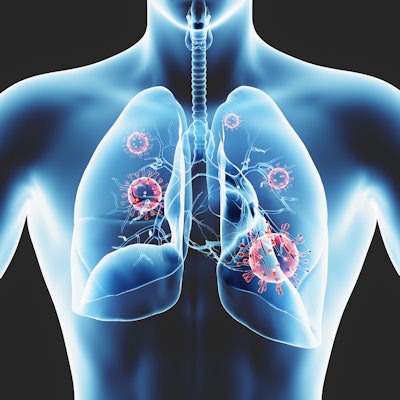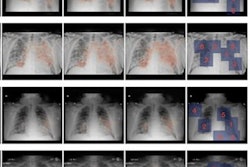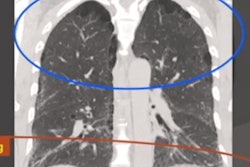
A deep-learning algorithm improves CT's capability for distinguishing between COVID-19 and other pneumonias, according to a study published February 27 in Interdisciplinary Sciences: Computational Life Sciences.
The results could make CT an even more effective tool in the midst of the COVID-19 pandemic and beyond, wrote a team led by Dr. Fudan Zheng of Sun Yat-Sen University in Guangzhou, China.
"CT detection [of COVID-19] is becoming an important tool in detecting infected patients because of its quickness and low false negative rate ... [but] the large number of CT images put large burdens on doctors to read them," the group wrote. "[It] is critical to develop a system that can not only diagnose COVID-19 when it is in intensive outbreak, but also distinguish COVID-19 from routine examinations when the outbreak is under control. Therefore, it is urgent to develop computer aided CT diagnosis systems to assist doctors in identifying suspected cases."
Artificial intelligence with CT for COVID-19 has typically been used to identify infected people or to differentiate COVID-19 patients from those with bacterial pneumonia. But there is less data regarding the use of AI and CT for distinguishing COVID-19 pneumonia from other types of viral infection.
Zheng's group conducted a study that included 659 patients. The group developed a deep-learning algorithm that combined the ResNet50 backbone with squeeze and excitation (SE) blocks and investigated whether the algorithm could distinguish among the following four types of CT exams:
- COVID-19 (262)
- Bacterial pneumonia (100)
- Viral pneumonia (219)
- Healthy controls (78)
Zheng's team measured the model's area under the receiver operating curve (AUC), its F1-score (which measures a model's accuracy), its precision, and its recall rate. The F1-score, precision, and recall rate values were calculated by mathematical formulas, with higher values indicating better performance; in particular, a high recall value was important "because a higher recall means that fewer COVID-19 patients will be missed, which can greatly prevent further infection by missed diagnoses," the group wrote.
The investigators found that the deep learning model had an overall accuracy AUC of 0.94 for distinguishing among the four types of CT exams and that it performed effectively among the other metrics as well.
| Deep-learning algorithm's performance in distinguishing among healthy patients, COVID-19 patients, and those with other pneumonias | ||||
| Measure | Healthy patients | Bacterial pneumonia patients | Typical viral pneumonia | COVID-19 patients |
| AUC | 0.99 | 0.97 | 0.95 | 0.93 |
| F1-score (accuracy measure) | 0.98 | 0.98 | 0.89 | 0.91 |
| Precision | 1 | 0.97 | 0.96 | 0.85 |
| Recall | 0.97 | 1 | 0.83 | 0.97 |
The model shows promise for helping clinicians better diagnose patients presenting with pneumonia symptoms, according to the authors.
"This model has the potential to become a daily used tool for doctors to classify pneumonia patients especially when COVID-19 may become a long-term existing virus," they concluded.





















